Heritage
Tallahassee Bicentennial

Tallahassee became the capital of the territory of Florida on March 4, 1824. It was chosen for its beauty and because it was the midway point between St. Augustine and Pensacola, the principal cities where legislators were conducting government business at the time. The city got its name from a Muskogean Indian word meaning "old fields."
To commemorate Tallahassee's Bicentennial, the City is producing a video series, "Tallahassee—200 Years in the Making." Episode 1: 1824-1835.
Dream Builders: Voices of the Movement

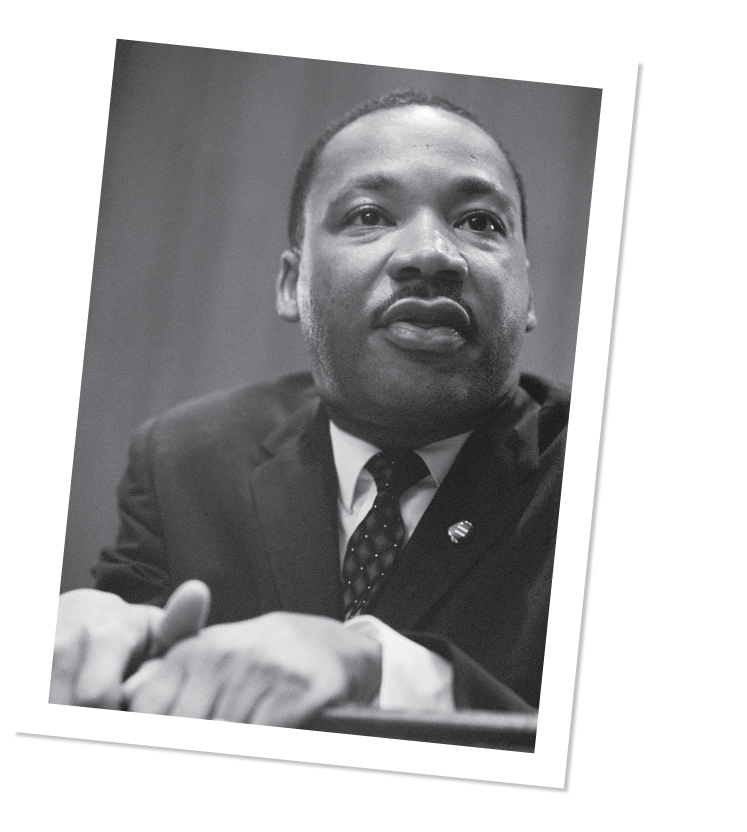
The City of Tallahassee aims to be a creative capital city that supports a strong community with vibrant neighborhoods. In line with that vision, in July 2020, City staff began working collaboratively with representatives from neighborhoods adjacent to Martin Luther King Jr. Boulevard (Levy Park, Frenchtown, Carolina Oaks and South Bronough Street) to implement small-scale enhancements that would celebrate and beautify the corridor. The resulting project was Dream Builders: Voices of the Movement. It includes the installation of interpretive markers and benches at three locations. The effort was financed by a grant from Keep America Beautiful (KAB) after a nationwide call for projects that enhance the corridors of streets around the country named for Dr. Martin Luther King Jr.
The interpretive markers tell stories of Dr. King’s visits to Tallahassee, local civil rights leaders and foot soldiers of the movement. In addition, the project included sidewalk art for several driveways and sidewalks along the corridor in the Frenchtown/Carolina Oaks neighborhoods.
Tallahassee’s Martin Luther King Jr. Boulevard spans 2.37 miles and traverses six neighborhoods, from Florida A&M University on the southern end to North Monroe Street. Neighborhoods along the corridor are rich in history, and older residents have many stories of the time Dr. King spent here.
Marker 1: (located near Florida A&M University, just south of FAMU Way) This marker honors Martin Luther King Jr. and his broader work for civil rights throughout the United States, as well as the activism of local civil rights leaders who lobbied the City Commission to rename Boulevard Street, stretching from Palmetto Street to North Monroe Street, to Martin Luther King Jr. Boulevard. This marker also honors community and civil rights activists Father David Henry Brooks, Reverend King Solomon Dupont and Edwina D. Stephens.
Marker 2: (located at 524 North Martin Luther King Jr. Blvd., Frenchtown Heritage Hub) This marker highlights Reverend Charles Kenzie (C.K.) Steele, his relationship with Dr. King, his involvement with leading Bethel Missionary Baptist Church in the civil rights movement and efforts for the Tallahassee bus boycott. The marker also honors those who served as “foot soldiers,” providing logistical support for the movement, including Lessie Graham Sanford and Cornelia Roberts Osborne.
Marker 3: (located on the corner of Seventh Ave. and Martin Luther King Jr. Blvd.) This marker honors the history of the Levy Park neighborhood, desegregation in Leon County Schools and the work of early pioneers, including Elaine Thorpe, Philip Hadley, Marilyn Holifield, Melodee Thompson and Harold Knowles, in their respective roles of integrating the local school system. The marker also honors Dr. King’s advocacy for education.
History of Jake Gaither Golf Course
 On May 1, 2023, the City of Tallahassee's Jake Gaither Golf Course celebrated another milestone in its rich 66-year history. The legendary golf course's much anticipated historical marker was unveiled during a special community celebration.
On May 1, 2023, the City of Tallahassee's Jake Gaither Golf Course celebrated another milestone in its rich 66-year history. The legendary golf course's much anticipated historical marker was unveiled during a special community celebration.
Added to the National Register of Historic Places on Aug. 9, 2022, by the National Park Service, the nine-hole course was opened in 1956 by the City, giving African Americans a place to play golf during a time when they were restricted from playing elsewhere. It quickly became a community hub, serving as the site of Guinness World Record attempts and home base for the Florida A&M University Golf Team until the early 1970s. Today, Jake Gaither Golf Course shines brighter than ever, welcoming thousands of golfers each year from every walk of life.
Attaining this prestigious designation took years of research and documentation, an effort spearheaded by Scott Edwards, a historic preservationist and the Florida Historic Golf Trail Coordinator at the Florida Department of State. To encapsulate this newest milestone, the City created a book of the research completed to earn the historic designation, taking the reader on a journey from the arrival of golf in Florida circa 1886 to the 1952 land purchase by the City that would allow for the development of the Jake Gaither Golf Course to course renovations in 2021.
Read the Full History of Jake Gaither Golf Course.
Tallahassee Civil Rights Memorial and the Four Corners of History
On Aug. 25, City of Tallahassee and community leaders joined together for the unveiling of the Cascades Historical Markers. The new installations include a Tallahassee Civil Rights Memorial and the Four Corners of History. Visit and learn about local history. The installations are located in the plaza off Gaines Street behind the AC Hotel near Cascades Park.
Journey to Emancipation
“Journey to Emancipation,” a statewide history conference, was presented by the City of Tallahassee's John G. Riley Center/Museum and the Florida African American Heritage Preservation Network, Dec. 5-7, 2021, in Tallahassee, Fla. Its focus was to bring awareness about the Emancipation Proclamation, Florida's emancipation date (May 20, 1865), the 13th Amendment and other interrelated topics of historical relevance.
FAMU Way

The FAMU Way Extension Project will create a new east-west roadway between the current end of FAMU Way at Wahnish Way and Lake Bradford Road and includes enhancements to the existing FAMU Way corridor. The project will be completed in three phases.
Explore the History of FAMU Way
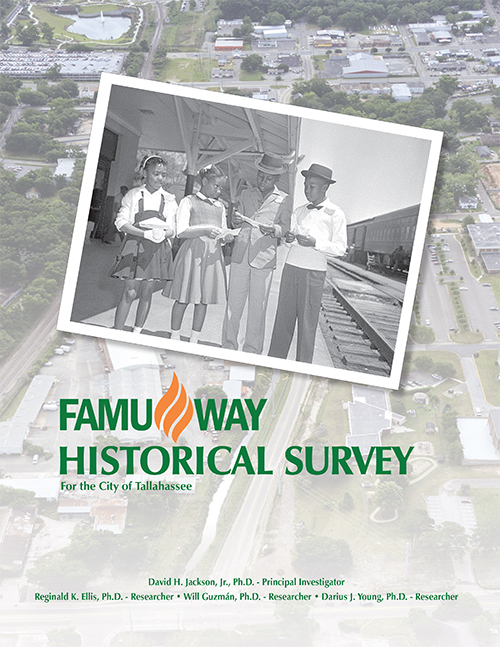
From the earliest stages of the project, the City has been committed to recognizing the history of the area along FAMU Way. Through interactions with the community, stories emerged of resilient neighborhoods, civil rights advocates and leaders and hard-working families. The City contracted with FAMU history professors to capture and share these stories with a goal of incorporating them into the FAMU Way Project. Dr. David Jackson, along with Drs. Reginald Ellis, William Guzman and Darius Young with the History department at Florida A&M University (FAMU) collected information from area residents and produced a historical survey that tells the story of the people, places and events that have helped shape the community.
Download the FAMU Way Historical Survey
To learn more about the research team who worked hard to create this survey, download our Biographical Sketches companion document.
[Photos: Photos pulled from the State Archives of Florida, Florida Memory
See more...
Smokey Hollow

During the late nineteenth and early twentieth centuries, the area just east of downtown Tallahassee and west of Myers Park Drive was an African American community called Smokey Hollow. According to the Tallahassee City Directory, published in 1904, there were five houses on Riley’s block on Jefferson Street, all owned by black men. In 1919, there were six homeowners and they too were black. Several other homes, owned or rented by blacks, surrounded the Riley property, extending up College and Gadsden Streets. This situation changed in the 1950′s, when plans for the Department of Transportation Building and the expansion of Apalachee Parkway encroached into the boundaries of the Smokey Hollow community. By 1978, only two houses remained, that of John Riley and John Hicks, a black tailor who lived across the street from Riley. Hicks died in the early 1970′s and his home was purchased by Colmar Corporation for speculative purposes. (Description provided by RileyMuseum.org)
See more...
Honoring Althemese Barnes
In recognition of her years of dedicated service preserving local history, the City of Tallahassee honored Althemese Pemberton Barnes by dedicating a park in her honor, located adjacent to Smokey Hollow, on September 20, 2022.
Althemese Pemberton Barnes is the preeminent leader locally in the preservation and recognition of African American history. After 30 years of employment with the State of Florida, she founded the John Gilmore Riley Center and Museum in January 1996, which was the first community-based African American historic museum in Tallahassee. While formally retiring as the museum's director in 2020, she continues to be active with it and currently serves as Executive Director Emeritus. Over the years, her work helped preserve local history and spaces including the Frenchtown Marker Trail; Hickory Hill, Munree and Greenwood Cemeteries; Cascades Heritage Trail and Civil Rights Wall; FAMU Way Historical Trail; and Smokey Hollow Commemoration.
"Althemese Pemberton Barnes is a true Tallahassee treasure. Her commitment to preserving Black history has taught our community so much and will profoundly impact generations to come. Naming this park in her honor, at the former site of one of Tallahassee's most iconic neighborhoods, is a fitting tribute," Mayor John Dailey said.
Prime Meridian Marker
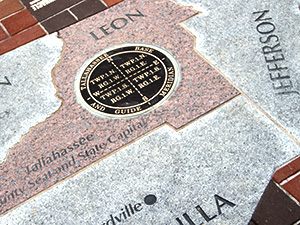 In the middle of the park is something that links all Floridians together - the Prime Meridian Marker. This marker, which was originally set in 1824, is the beginning point for all land surveys in the state of Florida, and it's the original southeast corner for Tallahassee's first boundary. Today, the marker is housed inside a map of Florida, which is inlaid into the bottom of the Prime Meridian Plaza, with colorful bricks and sturdy granite.
In the middle of the park is something that links all Floridians together - the Prime Meridian Marker. This marker, which was originally set in 1824, is the beginning point for all land surveys in the state of Florida, and it's the original southeast corner for Tallahassee's first boundary. Today, the marker is housed inside a map of Florida, which is inlaid into the bottom of the Prime Meridian Plaza, with colorful bricks and sturdy granite.
Korean War Memorial
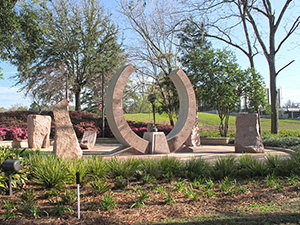 Beyond these two landmarks, there is still plenty to learn in Cascades Park. For example, there is the Korean War Memorial and informational panels strategically placed throughout the park that make for great reading when walking the many trails. Did you know that "Famous Amos" of Famous Amos cookies has a tie to the park? Learn more about that and other fun Tallahassee tidbits while exploring Cascades Park.
Beyond these two landmarks, there is still plenty to learn in Cascades Park. For example, there is the Korean War Memorial and informational panels strategically placed throughout the park that make for great reading when walking the many trails. Did you know that "Famous Amos" of Famous Amos cookies has a tie to the park? Learn more about that and other fun Tallahassee tidbits while exploring Cascades Park.
Community Remembrance Marker
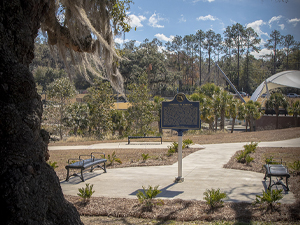 The Community Remembrance Marker stands in Cascades Park to remember and acknowledge those who were killed by lynching. There were four documented lynchings in Leon County: Pierce Taylor (1897), Mick Morris (1909), Richard Hawkins (1937), and Ernest Ponder (1937). The location of this marker was chosen because of its proximity to the two Leon County jails the men were taken from before they were lynched. The jails were located on the south side of Gaines Street between Meridian and Gadsden Streets. The Tallahassee City Commission approved placement of a narrative marker remembering these men on July 8, 2020, and the Tallahassee Community Remembrance Project partners hosted a dedication and unveiling ceremony on July 17, 2021. For more information, visit tallahasseeremembrance.com.
The Community Remembrance Marker stands in Cascades Park to remember and acknowledge those who were killed by lynching. There were four documented lynchings in Leon County: Pierce Taylor (1897), Mick Morris (1909), Richard Hawkins (1937), and Ernest Ponder (1937). The location of this marker was chosen because of its proximity to the two Leon County jails the men were taken from before they were lynched. The jails were located on the south side of Gaines Street between Meridian and Gadsden Streets. The Tallahassee City Commission approved placement of a narrative marker remembering these men on July 8, 2020, and the Tallahassee Community Remembrance Project partners hosted a dedication and unveiling ceremony on July 17, 2021. For more information, visit tallahasseeremembrance.com.
USS Tallahassee Commemorative Bell
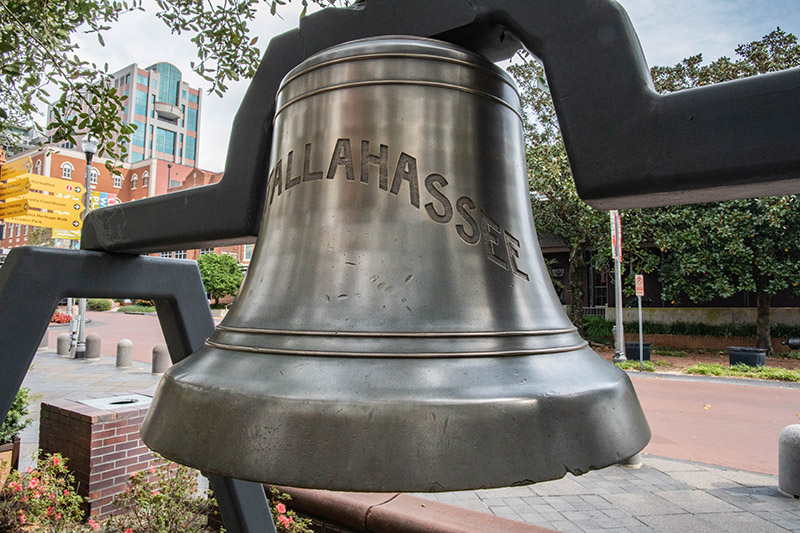
The USS Tallahassee was launched on Nov. 30, 1901, and commissioned as the USS Florida on June 18, 1903. The Florida was renamed Tallahassee (IX-16) on July 1, 1908, to free the State name for assignment to a new Navy ship. She had a crew of 220 officers and enlisted personnel.
At various times between 1906 and 1917, the USS Tallahassee served as the Naval Academy's midshipman training ship, trained Naval Reservists and conducted ordnance experiments. She was the ship chosen to prove that stacked turrets would be safe and effective. In 1915, she was converted to a submarine tender. During World War I, the USS Tallahassee served in the Canal Zone, the Virgin Islands and the Bermuda areas, earning the World War I Victory Medal. She was decommissioned on March 24, 1922.
A model of the Navy ship is on display at the Museum of Florida History.
The 320-pound bronze bell of the USS Tallahassee has resided in front of City Hall since Nov. 9, 2010. Prior to that, it was under the stewardship of the Greater Tallahassee Chamber of Commerce for 38 years (1972-2010).
"Eleven years ago, it was my privilege to lead efforts that resulted in the prominent display of the historic bell to honor our veterans from all branches of the service," said David Ramsay, community supporter and activist. "We can never say thank you often enough to those who have protected our freedom."
The bell can be viewed outside of City Hall.